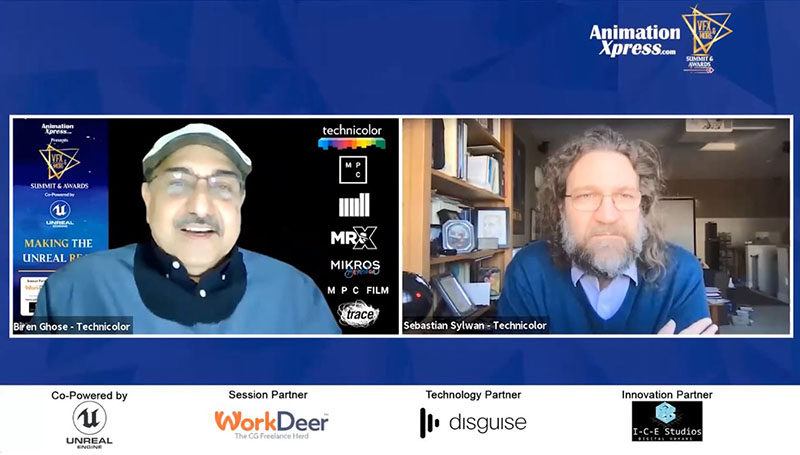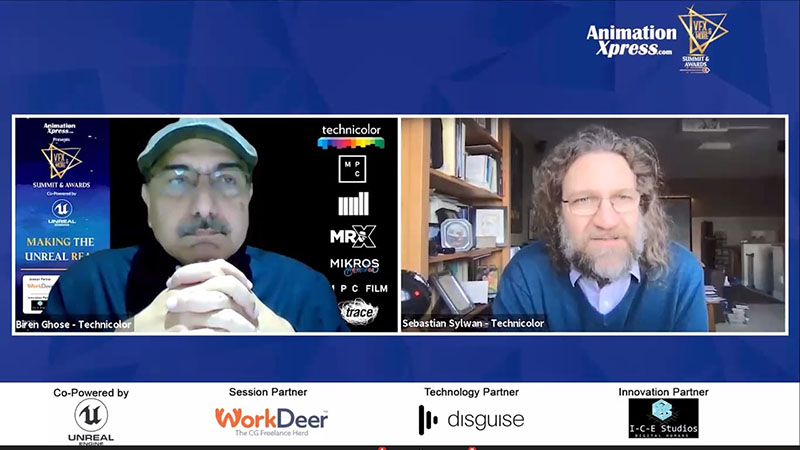Co-powered by Unreal Engine, VAM Summit’s session titled ‘Curtain Raiser: Powering the Future of VFX’ saw an insightful discussion between Technicolor CTO – Production R&D Sebastian Sylwan and Technicolor Country Head Biren Ghose about the next generation of VFX content which is being enabled and informed by software and creative collaboration.
Creative Collaboration
Creativity has been greatly enhanced by interactive media and technology taking storytelling into a new immersive paradigm; generating a new visual language. Exploring the evolution of Computer Graphics and the changes and trends taking place in the future, Sylwan shared that content creation, in general, is the most collaborative art form. He shared that the covid has put the industry into high gear and jolted the world into accelerating the adoption of digital tools to leverage that collaboration.
Sylvan shared, “Anything that removes the layer on the creative intent, makes things more intuitive and frees up the path to creation is what would point towards the next generation of technology. The common theme across various technologies is that it helps remove the layers and increase the immediacy between the creative intent and its realisation.”
Ghose pointed out the diversity of visual effects which made people embrace more themes. Touching upon various proprietary software and tools for explosion, water, fur, crowds along with the community of open-source software has ushered in a kind of democratisation. Ghose explored the parallel dynamic of content creation and where it is headed in the future.
Expanding on the importance of the emerging tools, Sylvan shared, “This is all we do; making sure that our tools contribute to the collaborative process of filmmaking and all the infrastructure that we’ve put in place around things serves to improve the creative output of the entire crew of the building. And so I do think that there is that this industrialisation brings some ease to the processes and at the same time we want to continue innovating.”
Innovations & Trends
On being asked by Ghose whether the innovations that are happening live are up to the appetite and “if the current ones are really the game-changers that make it bigger, better, faster, simpler and more available?” Sylvan answered, “Like most innovations, we’re standing on the shoulders of giants. So now you have things that are certainly compounding the value or the technology that has been built until now.” Sylvan opined that it is much more difficult today to make a groundbreaking discovery “but we are seeing some of it in some areas.”
Appending his view on the ongoing evolution of technology, he added, “We are still seeing it specifically in areas like ‘Machine Learning.’ It is all about how can they be leveraged to serve at scale and how they can be leveraged in order to do the entire filmmaking.”
Game Engines Powering Content
Touching upon the territory of immersive storytelling with the growing ubiquitousness of game engine technology in all kinds of live-action production and how they can be democratised and made accessible to creators, Sylvan asserted, “Certainly the availability of game engines has lowered the barriers of entry dramatically. So it is very much something that is now accessible to an individual student even at home wanting to try things with a very limited investment and that is fantastic news in general for the content creation industry because we will get a lot more ideas and people and talents and that will be bringing new blood or energy into the content. And so definitely, it is a huge huge advantage that way.”
Sylvan informed that for any new technology or any new medium, specifically about immersive technologies, there are multiple applications. He shared, “We still need to develop the language and understanding of its perception. We need to develop how we elicit new emotions in the audience through the use of immersive media.”
Sylvan feels that the biggest element of this instrument’s usefulness is still the fact it allows a very different mode of collaboration. He shared, “They allow a sort of collaboration in which we remove the abstraction of a sketch to a very practical interaction with an environment that feels physical even though it isn’t.”
Allaying Perceived Limitations
Sylvan feels that it is their role as filmmakers applying this technology to dispel any notions and concerns that directors might feel. Content creators might feel that they are locked into their choices and there is less room for improvisations and happy accidents.
He shared, “You need to say that you are actually providing a way to explore those creative opportunities, to challenge some assumptions, to test things in a much easier and faster way and that it doesn’t necessarily remove that ability.”
They agreed that it is overall a big advantage, especially for the generation of filmmakers, born or natively interacted with these tools since a very early age and they really don’t see the tool. The tool completely disappears and they just bring their creativity to play.
Advice to the young generation of artists
Sylvan feels it is easy to get lost in the rabbit hole of technicalities so rather than focusing on all things, one must lay emphasis on the fact that the creative intent needs to be at the centre and collaboration is an essential part of it.
He shared, “Even when we’re doing interactive experiences for an advertising project or a short on whatever level we operate, we’re still telling stories, which is probably the most fundamental human characteristics and that’s where our aim and our focus should be even when we do it through a very sophisticated narrow slither of a piece of technology.”
The paradigm shift in content production has necessitated the recalibration of existing workflows and pipelines but the question still remains if the filmmakers have come around to it yet.


